Liquid Adhesives Market Research, 2033
The global liquid adhesives market was valued at $38.3 billion in 2023, and is projected to reach $56.7 billion by 2033, growing at a CAGR of 4% from 2023 to 2033. Liquid adhesives are substances in a fluid state that are used to bond materials together. They come in various formulations, including water-based, solvent-based, and reactive types. These adhesives are typically applied in liquid form and then allowed to cure or dry, forming a strong bond between surfaces. Liquid adhesives are versatile and can be used for a wide range of materials, including paper, wood, metal, plastic, and fabric. They are commonly used in industries such as construction, automotive, electronics, and crafts.
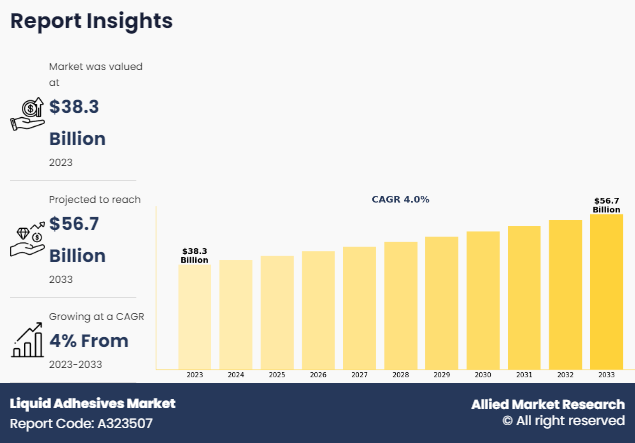
Key Takeaways:
- The report provides competitive dynamics by evaluating business segments, product portfolios, target market revenue, geographical presence and key strategic developments by prominent manufacturers.
- The liquid adhesives market is fragmented in nature among prominent companies such as 3M Company, Avery Dennison Corporation, Beardow Adams, Bostik SA, DIC Corporation, Dow Inc., H.B. Fuller Company, Henkel AG & Co. KGaA, Huntsman Corporation, and Pidilite Industries Ltd.
- The study contains qualitative information such as the market dynamics (drivers, restraints, challenges, and opportunities), public policy analysis, and Porter’s Five Force Analysis across North America, Europe, Asia-Pacific, LAMEA regions.
- Latest trends in global liquid adhesives market such as undergoing R&D activities, regulatory guidelines, and government initiatives are analyzed across 16 countries in 4 different regions.
- More than 3,000 liquid adhesives-related product literatures, industry releases, annual reports, and other such documents of key industry participants along with authentic industry journals and government websites have been reviewed for generating high-value industry insights for global liquid adhesives market.
Market Dynamics:
The expansion of end-use industries such as automotive, construction, packaging, and electronics drives the demand for liquid adhesives. In the automotive sector, liquid adhesives are used for bonding components, reducing weight, and enhancing structural integrity. Similarly, in construction, liquid adhesives are essential for bonding various materials, including glass, metal, and composites, contributing to the development of modern architectural designs.
Moreover, continuous advancements in formulation technology have led to the development of high-performance liquid adhesives with superior bonding characteristics. Manufacturers are investing in R&D to create adhesives that offer enhanced strength, durability, and resistance to environmental factors such as temperature variations and chemical exposure. These innovations drive market growth by expanding the applicability of liquid adhesives across diverse industries.
In addition, growing environmental concerns and regulatory pressures are prompting industries to adopt environmentally friendly adhesive solutions. Liquid adhesives formulated with low volatile organic compounds (VOCs) and eco-friendly ingredients are gaining traction in the market. Manufacturers are focusing on sustainability by developing adhesives that minimize environmental impact without compromising performance, thus catering to the demand for green alternatives.
However, regulatory frameworks play a pivotal role in shaping the liquid adhesive market. Adhesives often contain volatile organic compounds (VOCs) and hazardous chemicals, leading to environmental and health concerns. Stringent regulations, such as Registration, Evaluation, Authorization, and Restriction of Chemicals (REACH) in the European Union and Environmental Protection Agency (EPA) guidelines in the U.S. impose restrictions on the use of certain chemicals, limiting the formulation options for adhesive manufacturers. Compliance with these regulations necessitates extensive testing, certification, and reformulation, increasing production costs and time-to-market for new adhesive products.
However, one of the primary opportunities in the liquid adhesive market lies in the integration of advanced materials. Industries such as automotive, aerospace, electronics, and healthcare are increasingly adopting lightweight materials, composites, and engineered plastics to enhance performance and efficiency. Liquid adhesives play a crucial role in bonding these advanced materials due to their ability to provide strong, durable bonds while accommodating the unique characteristics of these substrates. Thus, the increasing demand for advanced materials may rise the demand for liquid adhesives used for bonding various substrates which in turn may create lucrative opportunities for the liquid adhesives market.
Also, the liquid adhesive industry is witnessing rapid technological advancements aimed at enhancing adhesive performance, efficiency, and versatility. Innovations such as smart adhesives with self-healing properties, bio-based adhesives derived from renewable sources, and nanotechnology-enhanced formulations are opening new opportunities for adhesive manufacturers. These technological developments address current industry challenges as also pave the way for the development of next-generation adhesive solutions capable of meeting evolving customer demands.
Segment Overview:
The liquid adhesives market is segmented on the basis of formulation, substrate, end-user industry, and region. On the basis of formulation, the market is categorized into water-based, solvent-based, and others. By substrate, the market is classified into metal, plastic, glass, wood, and others. By end-user industry, the market is divided into automotive & transportation, building & construction, electronics, packaging, medical, and others. Region-wise, the market is studied across North America, Europe, Asia-Pacific, and LAMEA.
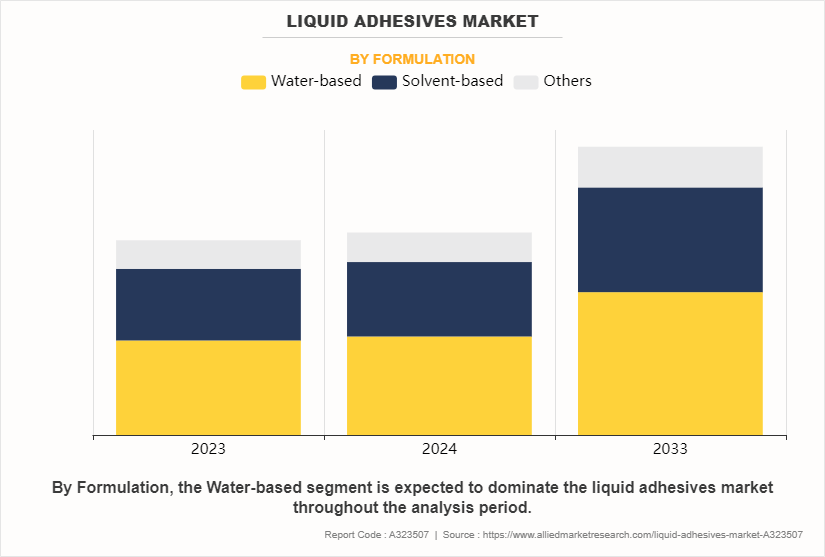
In 2023, the water-based segment was the largest revenue generator, and is anticipated to grow at a CAGR of 4.2% during the forecast period. Water-based adhesives offer improved health and safety benefits for workers compared to solvent-based adhesives, which often contain harmful chemicals and require stringent safety measures to prevent exposure. Furthermore, the shift towards water-based adhesives reduces health risks associated with inhalation of VOCs, skin contact with toxic chemicals, and potential fire hazards in industrial settings, enhancing workplace safety and employee well-being.
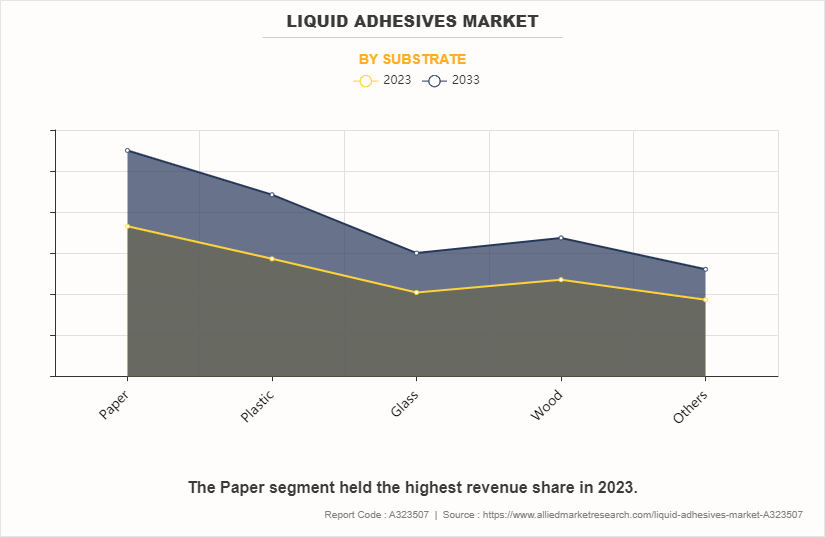
In 2023, the paper segment was the largest revenue generator, and is anticipated to grow at a CAGR of 4.2% during the forecast period. Many liquid adhesives formulated for paper applications have fast-drying properties, allowing for quick bonding and handling of paper materials. This feature is advantageous in high-volume production environments where fast assembly or packaging is required. Additionally, liquid adhesives can provide strong and durable bonds on paper substrates, ensuring that assembled products or packaging remain intact during handling, transportation, and use. This is especially important for applications such as packaging, bookbinding, and paper crafts where durability is crucial.
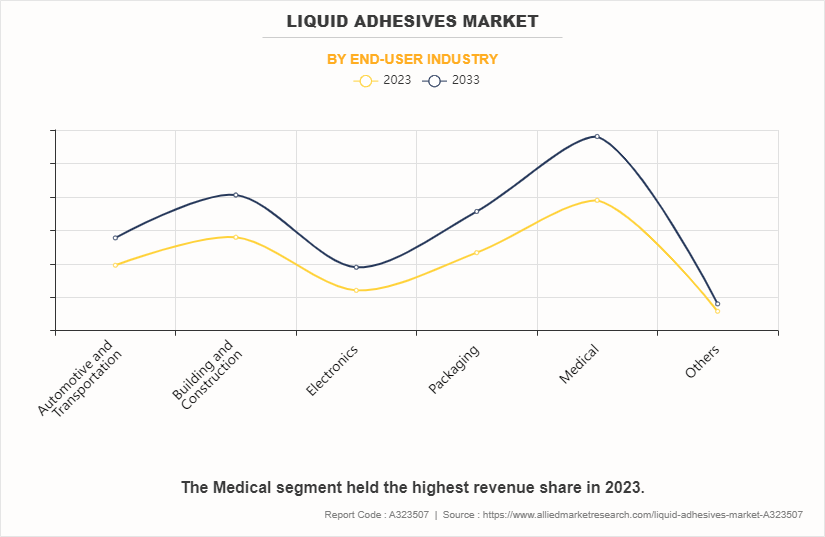
By application, the medical segment dominated the global market in 2023, and is anticipated to grow at a CAGR of 4.1% during forecast period. The growing trend towards minimally invasive procedures in healthcare drives the demand for adhesive technologies that enable precise and minimally traumatic tissue bonding. Liquid adhesives offer advantages in minimally invasive surgeries by providing strong and reliable tissue adhesion without the need for large incisions or sutures, leading to faster recovery times and reduced patient discomfort. Furthermore, liquid adhesives are used in the manufacture of advanced wound care products such as wound sealants, tissue adhesives, and skin closure strips. Moreover, these adhesives provide secure wound closure, hemostasis, and protection against infection while promoting a moist wound healing environment conducive to tissue regeneration.
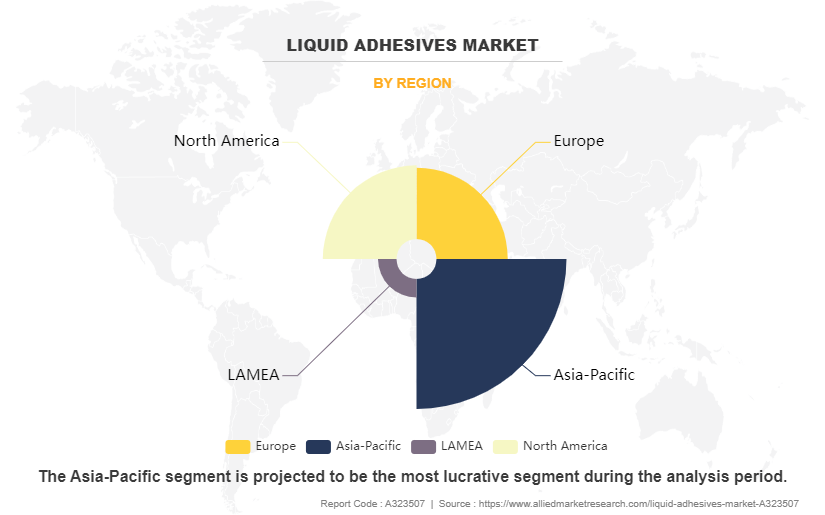
The Asia-Pacific liquid adhesives market size is projected to grow at the highest CAGR of 4.6% during the forecast period and accounted for 44.3% of liquid adhesives market share in 2023. The automotive industry in the APAC region is one of the largest and fastest-growing markets globally, driven by increasing vehicle production, rising disposable incomes, and expanding transportation infrastructure. Liquid adhesives are widely used in automotive manufacturing for bonding lightweight materials, sealing components, assembling interior and exterior parts, and enhancing vehicle performance, safety, and aesthetics. Furthermore, the APAC region is a major hub for electronics manufacturing, with countries such as China, Japan, South Korea, and Taiwan leading the production of smartphones, computers, consumer electronics, and semiconductor devices. Liquid adhesives are essential for electronic assembly, packaging, and component bonding, providing reliable and durable connections in devices such as smartphones, tablets, wearables, and automotive electronics.
The global liquid adhesives market profiles leading players that include 3M Company, Avery Dennison Corporation, Beardow Adams, Bostik SA, DIC Corporation, Dow Inc., H.B. Fuller Company, Henkel AG & Co. KGaA, Huntsman Corporation, and Pidilite Industries Ltd.
Competitive Analysis:
The global liquid adhesives marketn profiles leading players that include 3M Company, Avery Dennison Corporation, Beardow Adams, Bostik SA, DIC Corporation, Dow Inc., H.B. Fuller Company, Henkel AG & Co. KGaA, Huntsman Corporation, and Pidilite Industries Ltd.
Other key players involved in the manufacturing of liquid adhesive include DUNLOP INDUSTRIAL PRODUCTS PRIVATE LIMITED, Sundeep Chalks Mfg. Co., Astral Adhesives, Ellsworth Adhesives India PTY Limited, INNOMAX INDUSTRIES, Astra Chemtech Private Limited, Mayfair Biotech Pvt. Ltd., Revex Plasticisers Pvt Ltd., and others. The global liquid adhesives market report provides in-depth competitive analysis as well as profiles of these major players.
Key Benefits For Stakeholders
- This report provides a quantitative analysis of the market segments, current trends, estimations, and dynamics of the liquid adhesives market analysis from 2023 to 2033 to identify the prevailing liquid adhesives market opportunities.
- The market research is offered along with information related to key drivers, restraints, and opportunities.
- Porter's five forces analysis highlights the potency of buyers and suppliers to enable stakeholders make profit-oriented business decisions and strengthen their supplier-buyer network.
- In-depth analysis of the liquid adhesives market segmentation assists to determine the prevailing market opportunities.
- Major countries in each region are mapped according to their revenue contribution to the global market.
- Market player positioning facilitates benchmarking and provides a clear understanding of the present position of the market players.
- The report includes the analysis of the regional as well as global liquid adhesives market trends, key players, market segments, application areas, and market growth strategies.
Liquid Adhesives Market Report Highlights
| Aspects | Details |
| Market Size By 2033 | USD 56.7 billion |
| Growth Rate | CAGR of 4% |
| Forecast period | 2023 - 2033 |
| Report Pages | 449 |
| By Formulation |
|
| By Substrate |
|
| By End-User Industry |
|
| By Region |
|
| Key Market Players | Bostik SA., DIC CORPORATION, Huntsman Corporation, Dow Inc., 3M Company, Beardow Adams Ltd., AVERY DENNISON CORPORATION, H.B. Fuller Company, Pidilite Industries Ltd, Henkel AG & Co. KGaA |
Analyst Review
According to the CXOs of leading companies, the liquid adhesives market represent a dynamic interplay of technological innovation, industrial demand, regulatory compliance, consumer preferences, and macroeconomic factors. As industries evolve and innovate, the demand for liquid adhesives continues to grow across diverse sectors such as automotive, construction, electronics, packaging, healthcare, and consumer goods. Technological advancements in adhesive formulations, including water-based, solvent-free, and reactive adhesives, enable manufacturers to meet evolving performance requirements while addressing environmental concerns and regulatory standards. End-user industries such as automotive and electronics drive the demand for high-performance adhesives capable of bonding lightweight materials and facilitating miniaturization. Additionally, the rise of eco-conscious consumers and sustainability initiatives propel the adoption of eco-friendly adhesives with low VOC emissions and non-toxic formulations. Globalization and urbanization create opportunities for market expansion, while fluctuations in raw material prices and regulatory landscapes pose challenges for manufacturers. To succeed in this competitive landscape, adhesive companies must focus on innovation, customer-centricity, sustainability, and strategic partnerships to capitalize on growth opportunities and navigate market complexities effectively. By understanding and adapting to the diverse drivers shaping the liquid adhesives market, businesses can position themselves for long-term success and contribute to the advancement of adhesive technology in the global economy.
Industrial growth and manufacturing trends, technological advancements and product innovation, and growing consumer preferences and DIY market are the upcoming trends of Liquid Adhesives Market in the world.
Medical is the leading application of Liquid Adhesives Market
Asia-Pacific is the largest regional market for Liquid Adhesives
The global liquid adhesive market was valued at $38.3 billion in 2023, and is estimated to reach $56.7 billion by 2033, growing at a CAGR of 4% from 2023 to 2033.
3M Company, Avery Dennison Corporation, Beardow Adams, Bostik SA, DIC Corporation, Dow Inc., H.B. Fuller Company, Henkel AG & Co. KGaA, Huntsman Corporation, and Pidilite Industries Ltd are the top companies to hold the market share in the liquid adhesives market.
Loading Table Of Content...
Loading Research Methodology...



